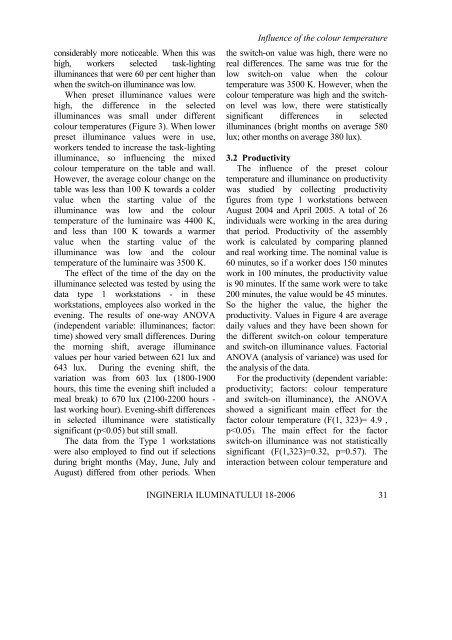This issue is sponsored by the Philips Romania, Lighting Division
This issue is sponsored by the Philips Romania, Lighting Division
This issue is sponsored by the Philips Romania, Lighting Division
You also want an ePaper? Increase the reach of your titles
YUMPU automatically turns print PDFs into web optimized ePapers that Google loves.
considerably more noticeable. When th<strong>is</strong> was<br />
high, workers selected task-lighting<br />
illuminances that were 60 per cent higher than<br />
when <strong>the</strong> switch-on illuminance was low.<br />
When preset illuminance values were<br />
high, <strong>the</strong> difference in <strong>the</strong> selected<br />
illuminances<br />
was small under different<br />
colour temperatures (Figure 3). When lower<br />
preset illuminance values were in use,<br />
workers tended to increase <strong>the</strong> task-lighting<br />
illuminance, so influencing <strong>the</strong> mixed<br />
colour temperature on <strong>the</strong> table and wall.<br />
However, <strong>the</strong> average colour change on <strong>the</strong><br />
table was less than 100 K towards a colder<br />
value when <strong>the</strong> starting value of <strong>the</strong><br />
illuminance was low and <strong>the</strong> colour<br />
temperature of <strong>the</strong> luminaire was 4400 K,<br />
and less than 100 K towards a warmer<br />
value when <strong>the</strong> starting value of <strong>the</strong><br />
illuminance was low and <strong>the</strong> colour<br />
temperature of <strong>the</strong> luminaire was 3500 K.<br />
The effect of <strong>the</strong> time of <strong>the</strong> day on <strong>the</strong><br />
illuminance selected was tested <strong>by</strong> using <strong>the</strong><br />
data<br />
type 1 workstations - in <strong>the</strong>se<br />
workstations, employees also worked in <strong>the</strong><br />
evening. The results of one-way ANOVA<br />
(independent variable: illuminances; factor:<br />
time) showed very small differences. During<br />
<strong>the</strong> morning shift, average illuminance<br />
values per hour varied between 621 lux and<br />
643 lux. During <strong>the</strong> evening shift, <strong>the</strong><br />
variation was from 603 lux (1800-1900<br />
hours, th<strong>is</strong> time <strong>the</strong> evening shift included a<br />
meal break) to 670 lux (2100-2200 hours -<br />
last working hour). Evening-shift differences<br />
in selected illuminance were stat<strong>is</strong>tically<br />
significant (p
















